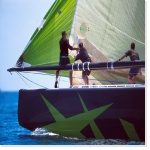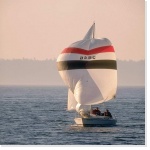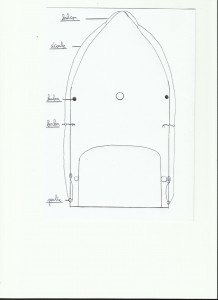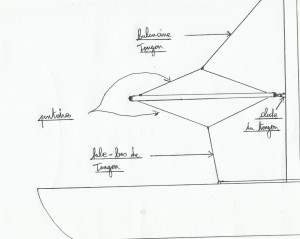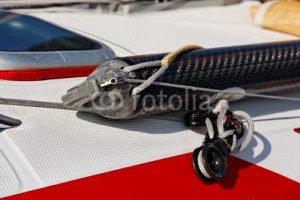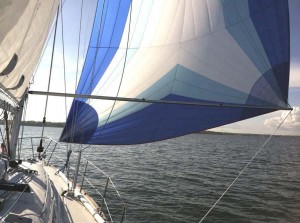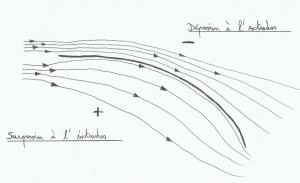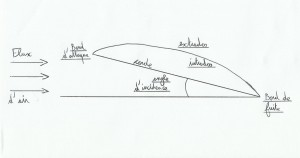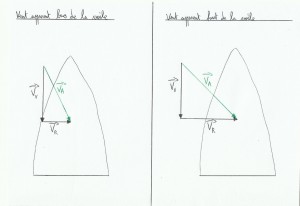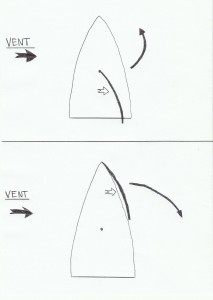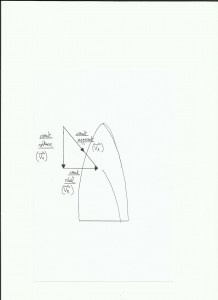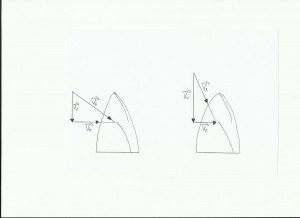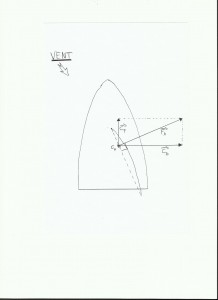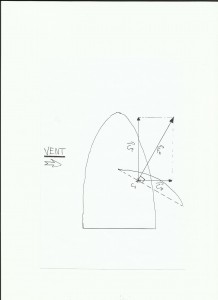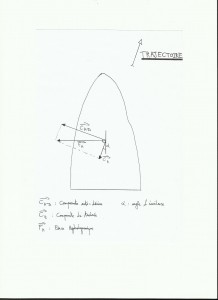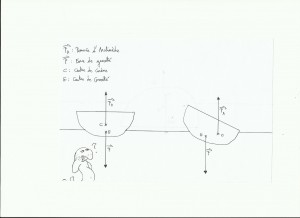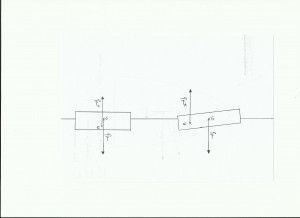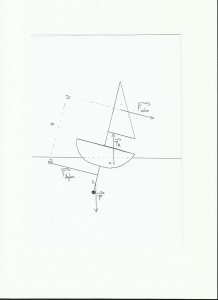Unlike other sails, this sail is made of nylon; it is the same fabric as the kites. Generally when you rent a cruising boat owner has difficulties to let it available, and a lot of people have clichés about its use “complicated”, but it's still a sail as an another and in navigation it's a shame to forget it.
1)Main things
There are several kinds of spinnakers, they can be classified in two main categories: symmetric and asymmetric spinnakers.
Symmetric: as its name suggests its shape is symmetrical. It's seen like a bubble shape with three points like a classic sail, so a head point, tack and clew. However, as this sail is symmetric we can use the clew as tack and tack as the clew, only the head of the sail can not be modified. The spinnaker is used with a long tube(made in alu, wood or carbon) called spinnaker pole, this tube is fixed to the mast and is mobile. In fact the spinnaker has the skill of having a mobile tack point both horizontally and vertically movable . This sail is used mostly between reach and run points of sailing, that's why it's use in regatta for banana's circuits.
You can see above a spi with a carbon pole(spi tack is near the end of the pole).
On this photo we see better the overall shape “bubble” of the symmetric spinnaker.
Asymmetrical spinnaker: as its name means, it's not symmetrical! Well, that's done, finished. In fact compared to the symmetrical type it will have things in common; it is also made of nylon, and it is also used in downwind. This sail has three points(head, clew, tack)but this time none are interchangeable, and it is also used with a tube where spi tack is fixed on its end. This tube is the bowsprit, it is fixed to the bow of the vessel and opposed to pole it is not movable in several directions, it can enter or leave the bow and that's all. asymmetric is mainly used between beam reach and reach points of sailing. This kind of spi is more found on cruising boats because it's easier to use it without pole presence.
After all this we will meet spi for smooth conditions, spi for the breeze…In fact the more wind will increase the more hoisted spi will be small and stout(heavier fabrics) and with a reduced depth.
2) Using the spinnaker
Preparation: at first barbers and sheets are set up, spinnaker is out on the deck last. The barbers are small pulleys where sheets pass through, a barber on each side of the boat is set up(the most of time there are chain plates made for barbers approximately located between the shrouds and the cockpit). Once barbers are in place we go on the bow, we link sheet's snap shackles on the pullpit(they are generally swivel-type, able to rotate 360 °) or on the guard line and we bring back them on the cockpit after having passed them in barbers, and the rear blocks and outside everything onboard(shrouds, guard line).
Once sheets outputs from rear blocks, they are rolled and we store the slack somewhere or we stock it on the guard line with a lark's head knot(also called by our poets friends monkey's bollocks…).we can set up sheets like this before leaving the harbour. We may also link spi's halyard on the bow with sheets but we have to pass it outside of everything(jib sheets, shrouds…)spi's halyard doesn't have to bother headsail's motions while it changes tack.
(Notice: spi's halyard is the highest in the mast, the topping lift has the least high exit in the mast.)
Spi pole: before installing the pole we must first know on which side we will hoist the spi, on which tack we will sail under spi. The pole is placed on the windward side of the boat, the spinnaker will be hoisted on lee side. pole's end linked to the boat is fixed on a chain plate on the mast(it is a kind of chain plate at the front of the mast that can be fix or mobile on a rail)and the front of the pole will host the spi sheet on windward side, called the spinnaker guy. pole is hoisted and maintained above with the topping lift, and is pulled from the deck with the down-hauler.
pole's ends are like that:
There is a jaw at each end, we open them by pulling a little rope .
Before hoisting the spinnaker pole we pass headsail's counter sheet above the pole and in front of the topping lift, with that in case of emergency we will be able to tack or gibe without stopping the headsail after having dropped spinnaker. The spinnaker guy is passed through the front jaw of the pole, and finally we hoist the pole perpendicular to the mast. Barber on windward side(through which the spinnaker guy pass)is hauled in at the maximum, the other barber is eased off.
Spi hoisting: we can finally bring spi's bag on the deck(after having checked before if it was correctly folded in…), by set it up the last time we avoid wetting it . First bag is attached to the boat to avoid its loss , and is attached to the boat's bow on pole's other side. We link spi's three points on sheets and the halyard, usually it's often time of mistakes; we must imagine the spinnaker when it will go out of the bag and inflate. we must avoid sheets turns around the pulpit or guard lines, the spinnaker guy must pass through the pole's jaw and the front of the forestay and above guard lines before being linked to the spinnaker. On the sail head point is easily noticeable with edge colors, sailing end which links green edge and red edge is head point. The halyard must be free of all before being attached to the sail(no turns around the forestay or shrouds…)and it is passed leeward of the headsail.
Spi hoisting is done broad reach, down wind you will risk an unforeseen gibe during spi maneuvering and on reaching spi will have more chances to be less covered by the other sails . We hoist it at this point of sailing to deflate the spi while it's hoisted( mainsail and headsail will deflate the spinnaker). At first we pull the spinnaker guy until tack point touches pole's end, and then we may hoist the spinnaker . Once the spinnaker set up we may roll or drop the headsail.
Basic setting: Spi's foot must be roughly parallel with horizon , for that we rise the pole to get tack point and clew point on the same level, and barber's sheet is also used for that(barber on lee side). The pole is perpendicular to the apparent wind and as much as possible perpendicular to the mast. Like any sail, the spinnaker must be hauled in until shivering limit, it must be always hauled in to show a slight shivering on luff's top(leading edge). The more we will be close to down wind, the more pole will move away from the forestay, the more we will be close to beam reach, the more the pole will be close to the forestay, it must never touch the forestay. Under spinnaker it's better to haul in a little the mainsheet, to give more wind in the spi, and do not pull too much the backstay to avoid mast rake and rolling, backstay has just to take the tense applied on the front of the mast.
(Notice: during a slight or moderate weather we may have wind abeam, we can be beam reach with a symmetric spi, however drift leeward of the boat will become important(because of the very curved section of the sail).To decrease it we may lower the pole's end to tighten the luff of the spinnaker up, do not forget to release the barber's sheet at maximum.)
(Notice: under spi, I personally like to keep the spinnaker halyard ready to be dropped at any time, so I turn it around a winch, and if I need to take down quickly I throw it in water and I open its cam cleat. In this way we avoid knots presence at the jam cleat's entry, and the spinnaker goes down more gently.)
(Notice: under spinnaker in slight weather we may release the pole down wind and use the spi like a kite sail, we may then haul in the mainsail in boat's axis to be quiet. When the spinnaker is swinging from right to left without possibility to stabilize itself, we set up the pole again.)
(Notice again: if under spinnaker the boat is a little too ardente to steer, we have to pull a little the spinnaker guy and release a little the sheet. Conversely, if the boat is too soft.)
(and hop an another notice: when there is a lot of wind you can keep the headsail inflated, it will then mask and deflate the spi, reduce its power and make it more controllable.)
Spi's dropping: there are several methods, the most safe for equipment is to get back to broad reach, and hoist the headsail. The spinnaker guy is released slowly(the spi guy must not come violently hitting the forestay)to pass the spi leeward of the sails and to deflete it. When the pole touches the forestay we completely release the spi guy, then being lee side of the boat we grab all spi's foot(we can help ourselves with the barber by harden it up), and finally we release the halyard and we take down the spi into its bag(can also be taken down in the companion way).
3)Using an asymmetric spy
It's almost the same thing, however there are some things different:
Preparation: this type of spinnaker looks like more as a conventional headsail, spi's tack is linked at the bowsprit's end, and spi sheets are both linked at clew point. When the spi is in its bag in front of the boat ready to be hoisted, the spi's counter sheet must pass in front of the forestay, and the tack's rope must pass above the spi's counter sheet(because during the jibe the spinnaker will change side between the forestay and its luff).
Hoisting: while the spinnaker is hoisted we must exit the bowsprit before to properly clear the spi from headsail and help it to inflate normally.
(Notice: for an asymmetric spinnaker normally we don't use barbers, but I like to keep them to pick up spi's foot more easily when I drop the sail)
Spi's dropping: we may store the bowsprit first to deflate the spi more easily.
An asymmetrical spinnaker open wide with the pole's help:
(Notice: under asymmetric spi there may be some apparent wind changes, particularly during boat accelerations, requiring the helmsman to bear away and change its course.)
4)Latest tricks
.If under spi the sail is flapping sharply, either we are too luffed, or we have to ease off the spi guy a little.
.If the sail starts to deflate in its middle, the mainsail is deflating the spi so it's meaning that we have beared away too much, or we need to take haul in the spi guy.
.The more we rise the spi in altitude, the more it will touch wind, but the most of time it's clew point's height which decide spi's height. It is always useful to have on board two sets of spi's sheets, light sheets for slight weather and heavy sheets for windy weather(light sheets will allow the spi to be inflated more easily, and we will feel more sensations in our tip fingers when we will handle the sheet).
.Spi folding is quite simple we just have to take care about twists in the sail and we let the sail's three points sticking out bag's exit, ready to be set up.
